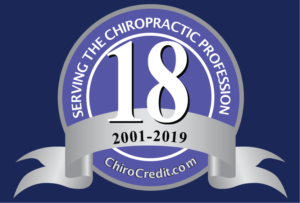Learn the basics about Evidence Based Practice for chiropractors and some quick strategies to search the scientific literature regarding chiropractic. Watch in HD for the best viewing experience.
Posts
Episode
 Dr. Hartvigsen and I discuss some important issues facing the profession including: 1) What is Evidence Based Practice?; 2) How do we build chiropractic’s academic capacity (and what are the barriers)?; 3) The Chiropractic Profession in the Mainstream; 4) How can we get the research out to chiropractors and the public?; 5) Musculoskeletal health in the context of general health; 6) The current situation in Australia (pediatric chiropractic).
Dr. Hartvigsen and I discuss some important issues facing the profession including: 1) What is Evidence Based Practice?; 2) How do we build chiropractic’s academic capacity (and what are the barriers)?; 3) The Chiropractic Profession in the Mainstream; 4) How can we get the research out to chiropractors and the public?; 5) Musculoskeletal health in the context of general health; 6) The current situation in Australia (pediatric chiropractic).
Professor Hartvigsen is Full Professor and Head of Research at the Department of Sports Science and Clinical Biomechanics at the Faculty of Health, University of Southern Denmark (SDU). He is also leading the Graduate Program for Physical Activity and Musculoskeletal Health and is co-founder of the Center for Muscle and Joint Health. He has published 136 scientific publications (67 in the past five years) including 26 systematic reviews, 13 editorials and commentaries and 10 book chapters and commissioned reports. His h-index is 26 and his work has received 1806 citations in the past five years. He has published as lead and senior author in leading general and musculoskeletal specialty journals such as BMJ, Spine, Pain, Osteoarthritis and Cartilage and Archives of Physical Medicine and Rehabilitation.
Invited Keynote Presentations:
Jan Hartvigsen has given 104 keynotes or invited presentations at meetings and multidisciplinary conferences in the fields of chiropractic, physiotherapy, back pain, and orthopaedics. Noticeably he has been invited to speak at the Forum for Research on Back Pain in Primary Care, World Congress on Low Back and Pelvic Pain (2x), World federation of Chiropractic Biennial Conference (4x), Forum on Manual Medicine, and The Nordic Congress on Musculoskeletal Physiotherapy and Musculoskeletal Medicine.
Research:
Jan Hartvigsen has received research support from numerous sources including from The Danish Regions 2001-2015, European Chiropractors Union 2012, Ontario Neurotrauma Foundation 2012, IMK General Foundation 2006-2015, Danish League Against Rheumatism 2011, Danish Agency for Science, Technology, and Innovation 2008, Danish Enterprise and Construction Authority 2008, Danish Board of Health 2005, Health Ressources and Service Administration (USA) 2009-2012. In total he has received over 50 million DKK in research support as lead or co-applicant since 2005.
Jan Hartvigsen has supervised 70+ MSc students during thesis work. He has completed supervision of 13 PhD students and is currently supervising 6 PhD students.
Prof Hartvigsen has peer reviewed 200+ manuscripts for 38 scientific journals including BMJ, Annals of Internal Medicine, Pain, Brain, and Annals of Rheumatic Diseases. He has reviewed submissions for 17 international conferences since 2007. He has reviewed grant applications from 13 agencies since 2005 including Canadian Institutes for Health Research, National Institutes for Health Research (UK), Arthritis Research UK, The BUPA Foundation (UK), WorkSafe BC (Canada), and The Wellcome Trust (UK). He has been examiner on 13 PhD theses in Denmark, Norway, Sweden, UK, Canada, Holland and Australia. Jan Hartvigsen has evaluated candidates for scientific positions at University of Sydney (AU), MacQuarie University (AU), Curtin University (AU), Keele University (UK), University of Toronto (Canada), University of Alberta (Canada), and all major Danish universities.
Teaching:
He has extensive teaching experience in the areas of research methodology, biostatistics, clinical examination and treatment of spine problems, and epidemiology. He has been responsible for establishing and coordinating courses in all of these areas.
Discover more of Dr. Hartvigsen’s publications on researchgate.
Links to Articles mentioned in the podcast:
| 1. | Beyond the spine: a new clinical research priority. |
| Donovan J, Cassidy JD, Cancelliere C, Poulsen E, Stochkendahl MJ, Kilsgaard J, Blanchette MA, Hartvigsen J. | |
| J Can Chiropr Assoc. 2015 Mar;59(1):6-12. | |
| PMID: 25729080 [PubMed] Free PMC Article | |
| Similar articles |
| 2. | Is it all about a pain in the back? |
| Hartvigsen J, Natvig B, Ferreira M. | |
| Best Pract Res Clin Rheumatol. 2013 Oct;27(5):613-23. doi: 10.1016/j.berh.2013.09.008. Review. | |
| PMID: 24315143 [PubMed – indexed for MEDLINE] | |
| Similar articles |
| 3. | Musculoskeletal disorders and work disability. |
| Hartvigsen J. | |
| Pain. 2013 Oct;154(10):1904-5. doi: 10.1016/j.pain.2013.06.036. Review. No abstract available. | |
| PMID: 23810853 [PubMed – indexed for MEDLINE] | |
| Similar articles |

Learn about Dr. Michael Schneider’s chiropractic research on this episode of Chiropractic Science. Dr. Schneider is a 1982 graduate of Palmer College of Chiropractic and obtained a PhD in Rehabilitation Science from the University of Pittsburgh in 2008. Dr. Schneider has published over 40 peer-reviewed articles on various musculoskeletal topics, and has received over $3 million in US research grant funding from the National Institutes of Health (NIH) and Patient Centered Outcomes Research Institute (PCORI). Dr. Schneider is currently implementing a large randomized clinical trial comparing various types of non-surgical treatment options, including chiropractic care, for patients with lumbar spinal stenosis. We will discuss the clinical significance of his past and present chiropractic research efforts.
Topics for this episode include:
- A paper published in the journal Spine comparing spinal manipulation and usual medical care for acute and subacute low back pain: a randomized clinical trial
- Evidence and the chiropractic identity
- An article regarding US chiropractors’ attitudes, skills and use of evidence-based practice: A cross-sectional national survey
- A paper in Chiropractic and Manual Therapies describing on ongoing study consisting of 180 older adults (>60 years) who have both an anatomic diagnosis of stenosis confirmed by diagnostic imaging, and signs/symptoms consistent with a clinical diagnosis of lumbar spinal stenosis confirmed by clinical examination. Treatment is randomized into 3 groups: 1) usual medical care; 2) individualized manual therapy and rehabilitative exercise; or 3) community-based group exercise.
- Three consensus documents for the chiropractic profession including: 1) chiropractic care in health promotion, disease prevention, and wellness; 2) chiropractic care of older adults and; 3) chiropractic care for infants, children, and adolescents.
- An observational intervention study dealing with a hospital-based standardized spine care pathway. The study looked at implementing a multidimensional spine care pathway (SCP) using the National Center for Quality Assurance (NCQA) Back Pain Recognition Program (BPRP) as its foundation. In the study, chiropractors were the main providers.
Here’s the link to the Foundations of Evidence Informed Practice modules that Dr. Schneider mentions in this podcast. The course is hosted at the the University of Minnesota Center for Spirituality & Healing – Advancing the health and wellbeing of individuals, organizations and communities.
http://www.csh.umn.edu/research/foundations-evidence-informed-practice-modules
Partner
Donate
Recent Episodes
- 066- Dr. Ronald Farabaugh – The Cost of Chiropractic vs Medical Management of Adults With Spine-Related Musculoskeletal Pain March 19, 2024
- 065- Dr. Clinton Daniels Discusses Manipulation and Prior Spine Surgery, Medications for Back Pain and More June 15, 2023
- 064- Dr. Matt Fernandez Discusses Physical Activity, Exercise and Chiropractic May 11, 2023
- 063- Dr. Robert Trager Discusses Spinal Manipulation, Lumbar Discectomy and Case Reports January 9, 2023
- 062- Dr. Lindsay Gorrell Discusses Spinal Manipulation, the Vertebral Artery, Reporting of Adverse Events January 3, 2023
- 061- Questioning the Relationship Between Chiropractic and ED Visits December 13, 2022
- 060- Dr. Brian Anderson Discusses Chiropractic, Treatment Escalation, Medical Services November 17, 2022
- 059- Dr. Frank Scali – Upper Cervical Spine and Myodural Bridge July 5, 2022
Security – SSL Certificate
Partner
 Chiropractic Science is a Miami University Digital Health Literacy Partner. Health literacy is the ability to read, write, and talk about health habits in a variety of life situations and environments. Our interprofessional partnership promotes the use and dissemination of electronic materials for evidence-based EHealth.
Chiropractic Science is a Miami University Digital Health Literacy Partner. Health literacy is the ability to read, write, and talk about health habits in a variety of life situations and environments. Our interprofessional partnership promotes the use and dissemination of electronic materials for evidence-based EHealth.

